
- Get in Touch with Us

Last Updated: Apr 25, 2025 | Study Period: 2023-2030
An automotive navigation system is an add-on from a third party or a component of the car's controls that helps drivers find their way. It frequently employs a satellite navigation system to determine its location, which is subsequently connected to a location on a road.
Routing calculations can be made when directions are required. The route can be changed on the fly based on traffic information, such as road closures, congestion.
In real-world scenarios, robotic systems and vehicles usually receive this information from GPS devices, gyroscopes, and magnetometers.
Sensors and System for Vehicle Navigation focused on a wide range of aspects of vehicle navigation, including big data processing for vehicle navigation, autonomous navigation, multisensor fusion, scientifically and technologically advanced sensors, analysis tools, and sensor synergy in navigation.
Autonomous vehicle navigation, in particular, has been at the centre of several significant advancements in both civilian and defence applications.
The quality of application fields is changing as a result of new technologies like multimodal data fusion, big data processing, and deep learning, which improve the sensors and systems employed.
Artificial intelligence has recently been shown to have an impact on how sensors process and understand data. In a variety of situations, unmanned vehicles and smart, adaptable platforms are equipped with radar, LiDAR, vision sensors, sonar systems, and other sensors.

The Global automotive navigation system sensors market accounted for $XX Billion in 2022 and is anticipated to reach $XX Billion by 2030, registering a CAGR of XX% from 2023 to 2030.
A passive unjammable highly accurate absolute position is provided by Honeywell's Vision Aided Navigation sensor system, which compares live camera feed optical and/or IR with maps.
This was proven on an Embraer E170 and resulted in a GPS-like performance, or horizontal position accuracy of 10m CEP50, in GPS-denied situations.
The Celestial Aided Navigation system from Honeywell uses a star tracker to monitor stars and Resident Space Objects (RSOs) in order to provide a passive, unjammable solution with GPS-like accuracy when GPS is unavailable or spoofing is present. An accuracy of 30m CEP50 was recently demonstrated using a ground vehicle.
| Sl no | Topic |
| 1 | Market Segmentation |
| 2 | Scope of the report |
| 3 | Abbreviations |
| 4 | Research Methodology |
| 5 | Executive Summary |
| 6 | Introduction |
| 7 | Insights from Industry stakeholders |
| 8 | Cost breakdown of Product by sub-components and average profit margin |
| 9 | Disruptive innovation in the Industry |
| 10 | Technology trends in the Industry |
| 11 | Consumer trends in the industry |
| 12 | Recent Production Milestones |
| 13 | Component Manufacturing in US, EU and China |
| 14 | COVID-19 impact on overall market |
| 15 | COVID-19 impact on Production of components |
| 16 | COVID-19 impact on Point of sale |
| 17 | Market Segmentation, Dynamics and Forecast by Geography, 2023-2030 |
| 18 | Market Segmentation, Dynamics and Forecast by Product Type, 2023-2030 |
| 19 | Market Segmentation, Dynamics and Forecast by Application, 2023-2030 |
| 20 | Market Segmentation, Dynamics and Forecast by End use, 2023-2030 |
| 21 | Product installation rate by OEM, 2023 |
| 22 | Incline/Decline in Average B-2-B selling price in past 5 years |
| 23 | Competition from substitute products |
| 24 | Gross margin and average profitability of suppliers |
| 25 | New product development in past 12 months |
| 26 | M&A in past 12 months |
| 27 | Growth strategy of leading players |
| 28 | Market share of vendors, 2023 |
| 29 | Company Profiles |
| 30 | Unmet needs and opportunity for new suppliers |
| 31 | Conclusion |
| 32 | Appendix |